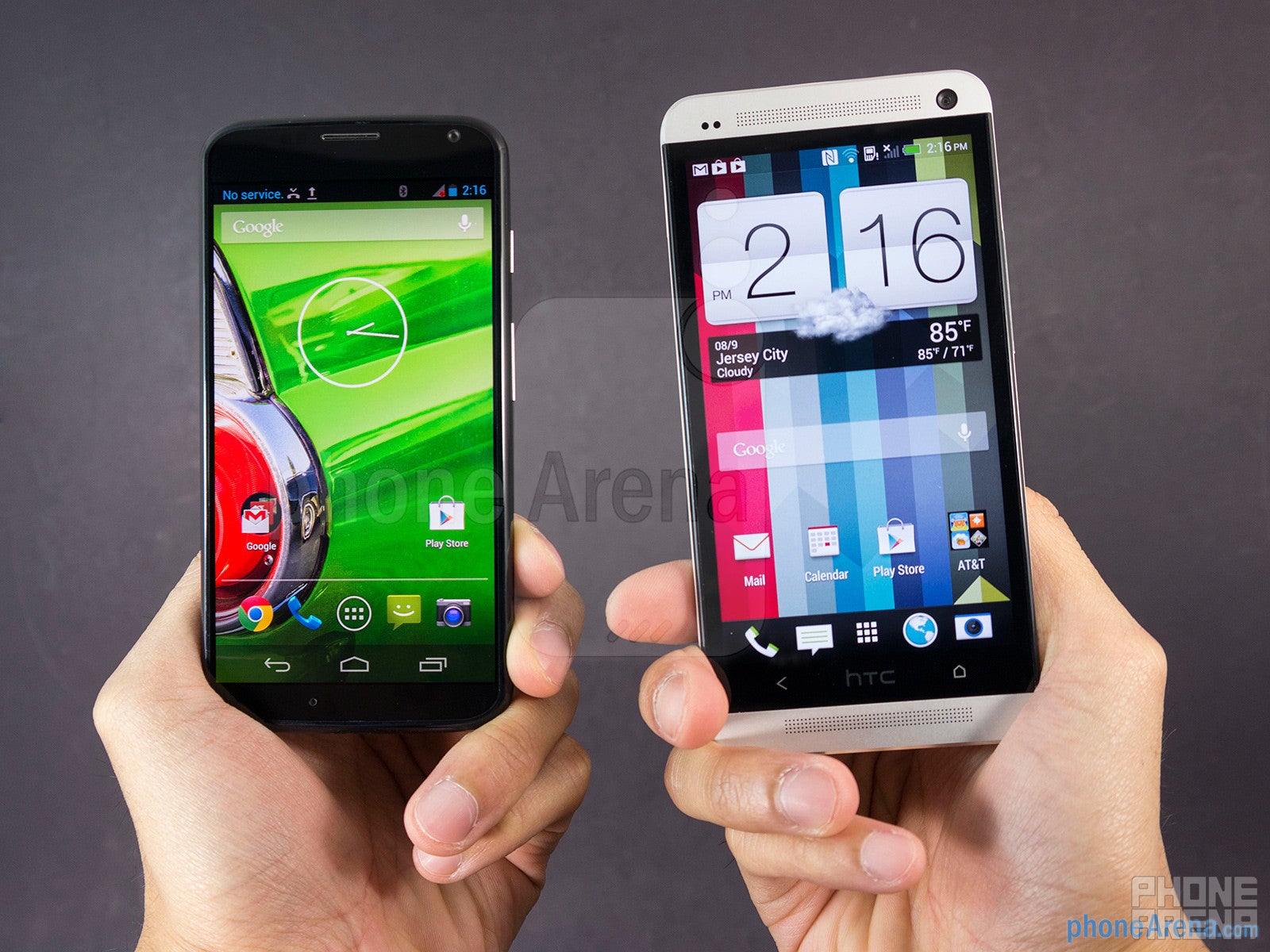Motorola Moto X vs HTC One

Introduction
In a strange way, both Motorola and HTC are in the same boat, as the two companies are contending in the Android space vying for the top spot, which is arguably taken up by Samsung’s presence. First out of the gate this year to launch, the HTC One has proven to be a venerable competitor in the landscape, as design and aesthetics are the most paramount aspects of the phone. Conversely, the Moto X is still at the early stage of its quest, but it takes a totally different approach with its modest offering and simplistic operation. No doubt, each one has their astounding features to reel people in, but it’s going to take a balanced offering to truly stand more prominently in this crowded space.
Design
Motorola is changing the way we think about the design process with the Moto X, as its upcoming Moto Maker portal makes for some interesting design mash-ups for the smartphone. However, it still doesn’t encompass the same level of quality craftsmanship, sturdy construction, and attractive design aesthetics seen with the HTC One and its brushed aluminum casing. Then again, we can’t count out form fitting nature of the Moto X, as it’s easier and more comfortable to hold in the hand – even more when they pack the same sized screens. When it comes downright to attraction, we’re still finding ourselves being pulled in by the HTC One.
Display
Matching one another with their 4.7-inch screens, there are various elements that help the cause of each device. On paper, the 1080x1920 S-LCD 3 display of the HTC One has the advantage with details over the 720x1280 AMOLED screen of the Moto X, but it’s something that’s not distinctively seen unless we look at the two closely – so from a normal distance, our eyes can’t tell their details apart from one another. For the Moto X, it stands out mostly for the skinny bezels on the left/right sides of its display, its deep black color, wide viewing angles, and vibrant color reproduction. Oppositely, the HTC One’s display produces the more realistic colors – while also proving to be the better of the two with outdoor visibility. It’s really tough to argue which one is superior, as people will have different preferences as to what they feel is more attractive.
Motorola Moto X 360-Degrees View
HTC One 360-Degrees View
Interface and Functionality
Looking deeply at the two phones, it’s obvious that HTC tinkered more with the visual presentation than Motorola, seeing that Sense 5 is heavy with its pronounced looks. In fact, you’d be hard pressed to believe that the HTC One is running Android from the homescreen – especially when its revamped visual aesthetics is rampant in many places throughout the platform. And if you happen to be big on social networking, HTC BlinkFeed is the perfect companion for your needs. However, hardcore Android users will no doubt be pleased by the Moto X’s experience, mainly due to the minimal tinkering with the interface’s visuals, but Moto’s approach is more focused on simplicity. Specifically, you have features like Motorola Assist, Motorola Connect, Active Display, and Touchless Control that are quite useful for many things.
Google Now is naturally on board with the two, but it’s the Moto X taking it up a notch with its new Touchless Control feature, which allows us to activate the service solely with our voice. It makes for a good hands-free experience, something that we don’t have yet with the HTC One.
Our snappy fingers like the on-screen keyboards of both devices, seeing that they match one another with their spacious layouts and quick responses. Despite that, the availability of numbers and punctuations from the main layout of the Sense keyboard propels the HTC One as the more favorable device for the task.
Processor and Memory
Seriously people, this comparison perfectly demonstrates that beefier specs don’t always translate to the better performance. It’s a dual-core versus a quad-core, so most people would presume that the dual-core 1.7GHz Qualcomm Snapdragon S4 Pro processor with 2GB of RAM in the Moto X wouldn’t stand a fighting chance against the more cutting-edge quad-core 1.7GHz Qualcomm Snapdragon 600 CPU with 2GB of RAM stuffed into the HTC One. Well, that’s not the case, as the Moto X delivers the snappier performance between the two – albeit, the flashy look of the Sense 5 UI might be the culprit behind the HTC One’s second place finish. We’re not saying it’s slow for HTC’s flagship, which exhibits mighty fine responses of its own, but as we look intently at the two, we can’t help but notice the Moto X’s better finesse.
| Quadrant Standard | AnTuTu | GLBenchmark 2.5 (Egypt HD) | Vellamo (HTML5 / Metal) | |
| Motorola Moto X | 8509 | 18483 | 6048 / 54 fps | 2412 / 749 |
| HTC One | 12481 | 23308 | 3551 / 31 fps | 2395 / 781 |
Comparing the base models of each, the Moto X packs only 16GB of internal storage – whereas the HTC One doubles the mark with its 32GB of space. Obviously, we’re more inclined to be cautious with the Moto X.
Internet and Connectivity
More than equipped for the web browsing experience, we don’t find one particular handset to be the preferred choice for this category. Not only are they both donning lightning fast 4G LTE connectivity for speedy page loads, they also boast the same level of responsiveness with pinch zooming, kinetic scrolling, and page rendering – a big fat win for the two!
Attached with the flagship status, it’s fitting that these two are made available in GSM and CDMA flavors. In addition, they’re packing all the customary set of connectivity features we find common in high-end phones – like aGPS, Bluetooth 4.0, dual-band 802.11 a/b/g/n Wi-Fi, and NFC. Certainly useful and providing another level of depth, the included IR blaster in the HTC One enables it to act as a universal remote.
Camera
Continuing its mentality of offering a simplistic experience, we’re not inundated with various functions and controls with the Moto X’s camera app. Instead, it’s as basic as it comes and mainly focuses on the function at hand – quickly taking photos! Meanwhile, the HTC One brings some serious features and manual controls with its camera app, which no doubt appeases those who have a flare for serious photography. Although we can quickly jump into the camera app through the HTC One’s lockscreen, we find the Moto X’s Quick Camera Capture feature to be more practical, as we basically need to twist our hand a couple of times to activate the camera app.
With their fancy termed cameras, the 10-megapixel “Clear Pixel” camera of the Moto X and the 4-megapixel “Ultrapixel” snapper of the HTC One, their qualities are dependent on the conditions. To be exact, the Moto X handles outdoor shots with plenty of lighting better – while the HTC One trumps its rival in low lighting conditions. Comparing the same photos on the computer, we notice that the Moto X captures finer details than the HTC One in sunny conditions, but then the Moto X’s results appear speckled and fainter under low light. It’s a tough call on which one we’d choose, since the results are opposite from one another.
Also a close finish, their 1080p video recording qualities rival one another in almost every category. They’re not 100% perfect, as we witness some artifacting elements in the video when panning quickly, but they both exhibit the same smooth capture speeds and gradual exposures.
Multimedia
Considering they both are preloaded with the Google Play Music app, the experience is nonetheless identical – though, as an alternative, the HTC One boasts its own Sense music player as well. Due to the fact that it’s packing along two front-firing speakers with HTC BoomSound, the HTC One’s audio quality proves to be the stronger and more commanding between the two at the loudest setting. Throw in Beats Audio support, the amplified tones when listening to music through the 3.5mm port of the HTC One is undoubtedly more robust than the Moto X.
Mostly due to that iridescent glow of the Moto X’s AMOLED panel, it makes for the better attraction with watching videos. Sure, the HTC One has the higher resolution screen, but like we mentioned already, it’s not something that’s distinctively prominent when we’re looking at the two from a normal distance.
Call Quality

Battery
In our experience, neither smartphone outlasts the other in the battery life department. The HTC One might be packing the higher capacity 2300 mAh battery, in contrast to the 2200 mAh stacked battery of the Moto X, but the results end up the same – we get a solid one-day of normal usage out of the two. Power users will get through an 8-hour work shift with no concerns, but they’ll require some charges to last throughout the day.
Conclusion
They’re Android smartphones at heart, yet, they differ greatly inside and out. As much as the two focus on certain aspects, we’re always left to factor in pricing to the mix, which is $200 on-contract for the two. Knowing that, it would seem as though you get more bang for the buck with the HTC One and its beefier specs, premium design, and inclusion of an IR blaster. Some would overlook the Moto X at that point, but that shouldn’t be the case at all. Whereas the HTC One is all about being meticulous with its design, both in its physical form and software experience, the Moto X is more humble with its totality. It doesn’t try to win us over with its hardware, nor does it try to bombard us with a ton of new software features. Overall, the HTC One is best suited for those with a flair for physical aesthetics and supreme social networking integration – while the Moto X is best reserved for those who are down for simplicity with the Android experience.



















Things that are NOT allowed: